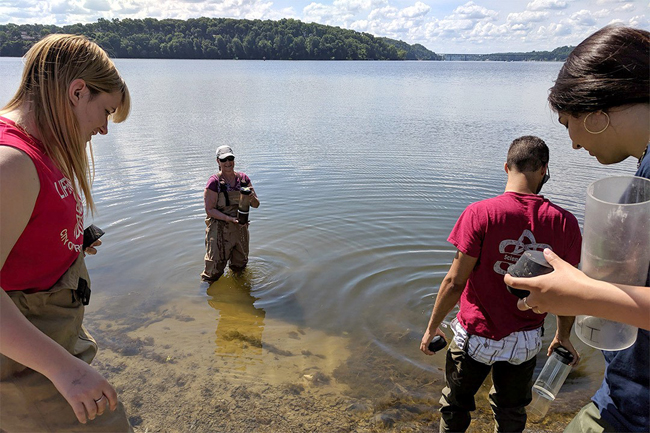
RIT researchers received funding to study the effects of microplastic pollution on Lake Ontario. RIT Associate Professor Christy Tyler, center, is pictured collecting sediment samples in Irondequoit Bay in 2019. Credit: Matthew Hoffman/RIT.
An interdisciplinary team is studying how microplastics accumulate in the lake's ecosystem
Contact:
Luke Auburn, Senior Communication Specialist, University Communications, Marketing and Communications, Rochester Institute of Technology, E: luke.auburn@rit.edu, P: 585-475-4335, Twitter: @ritnews, Web: www.rit.edu
Rochester, NY, May 27, 2020 - A team of Rochester Institute of Technology researchers will explore how tiny particles of plastic pollution are impacting Lake Ontario thanks to new funding from the National Oceanic and Atmospheric Administration's Sea Grant College Program. The multidisciplinary group led by Associate Professor Christy Tyler will examine how microplastics are transported and transformed in the lake, where they ultimately end up and what effects they have on the ecosystem.
Scientists have much to learn about how plastic debris accumulates in bodies of water and impacts the environment. Most of the research to date has focused on oceans or the surface of lakes.
While plastic has been found to accumulate in floating patches in oceans, models by RIT Associate Professor Matthew Hoffman show that in lakes, plastic is more likely to accumulate in the sediment at the bottom of lakes—the benthic zone. Tyler and her team will use mathematical modeling, field surveys, fluid dynamics, genomic sequencing and other experiments to look at how plastic is impacting the benthic zone and how wildlife and natural processes are transporting and further breaking down plastic.
"We want to get a better idea of the complete lifecycle of plastic once it hits the water," said Tyler, an associate professor at RIT's Thomas H. Gosnell School of Life Sciences and the principal investigator of the project. "And we don't look at plastic as a single type of material—different types can vary substantially in their transport, toxicity and persistence in the environment."
Tyler's co-PIs include Steven Day, head of RIT's Department of Biomedical Engineering; Nathan Eddingsaas, associate professor in the School of Chemistry and Materials Science; Hoffman, associate professor in the School of Mathematical Sciences; and André Hudson, head of the Thomas H. Gosnell School of Life Sciences. The grant will also provide funding for several undergraduate and graduate students to help conduct research.
Some of the plastics they plan to study include construction materials such as PVC, clothing fibers like polyester and packaging materials including polyethylene. The ultimate goal is to effectively inform policy, mitigation, prevention initiatives, resource management strategies and technical innovations to combat microplastic pollution.
This story is a product resulting from project R/CTP-55 funded under award NA18OAR4170096 from the National Sea Grant College Program of the U.S. Department of Commerce's National Oceanic and Atmospheric Administration, to the Research Foundation for State University of New York on behalf of New York Sea Grant. The statements, findings, conclusions, views and recommendations are those of the author(s) and do not necessarily reflect the views of any of those organizations.
More Info: New York Sea Grant
New York Sea Grant (NYSG), a cooperative program of Cornell University
and the State University of New York (SUNY), is one of 34 university-based
programs under the National Oceanic and Atmospheric Administration’s
National Sea Grant College Program.
Since 1971, NYSG has represented a statewide network of integrated
research, education and extension services promoting coastal community
economic vitality, environmental sustainability and citizen awareness
and understanding about the State’s marine and Great Lakes resources.
Through NYSG’s efforts, the combined talents of university scientists
and extension specialists help develop and transfer science-based
information to many coastal user groups—businesses and industries,
federal, state and local government decision-makers and agency managers,
educators, the media and the interested public.
The program maintains Great Lakes offices at Cornell University, SUNY
Buffalo, SUNY Oswego and the Wayne County Cooperative Extension office
in Newark. In the State's marine waters, NYSG has offices at Stony Brook
University in Long Island, Brooklyn College and Cornell Cooperative
Extension in NYC and Kingston in the Hudson Valley.
For updates on Sea Grant activities: www.nyseagrant.org has RSS, Facebook, Twitter, and YouTube links. NYSG offers a free e-list sign up via www.nyseagrant.org/nycoastlines for its flagship publication, NY Coastlines/Currents, which is published quarterly. Our program also produces an occasional e-newsletter,"NOAA Sea Grant's Social Media Review," via its blog, www.nyseagrant.org/blog.